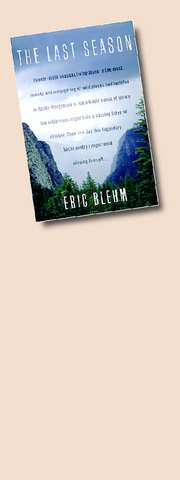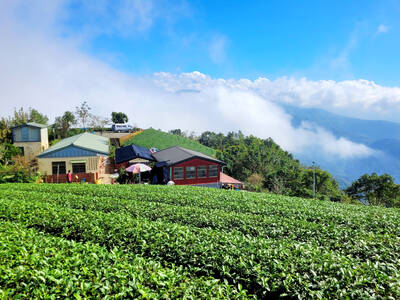Some travelers head for the wilderness in search of adventure. Some look for tranquillity. And some go hunting for the kinds of man vs. nature parables that Jon Krakauer (Into the Wild) and Werner Herzog (Grizzly Man) found: mysterious disappearances heightened by the drama of the landscape and its four-legged perils. When there's not much left of an outdoorsman other than his wristwatch, the details are gruesome, but the story has the
makings of a hit.
So the template for The Last Season is unmistakable. Eric Blehm, who was a serious High Sierra backpacker, not to mention the editor of a snowboarding magazine, has tried to shape the story of James Randall Morgensen along these familiar lines. Morgensen was a park ranger with a deep love of the outdoors. Then he suited up into his hiking gear, headed out into the backcountry of Sequoia and Kings Canyon National Parks and disappeared. What happened to him? More to the point, is there a book in it?

Regardless of the fair answer to that last question, Blehm has written a book. He begins by setting the scene. "A hermit thrush broke the alpine silence," he writes about the fateful morning of July 21, 1996, because Morgensen obliged his future biographer by recording the thrush's presence in his official logbook. Less officially, the once-rhapsodic Morgensen had been saying things like "I don't find much pleasure in the flowers anymore" and "after all these years of being a ranger, I wonder if it's been worth it." Then there were worrisome remarks in letters to friends: "Nothing seems predictable, except pain."
As The Last Season reveals, in steroid-enhanced versions of points that might shape a magazine article, there were obvious factors contributing to Morgensen's discouragement. He mourned the death of his father, Dana Morgensen, whose love of nature and job at Yosemite National Park had had a huge effect on his son. ("It was obvious that the cone hadn't fallen far from the pine tree.")
Dana's work had allowed his son to grow up in an extraordinarily inspiring setting. (The great nature photographer Ansel Adams was a family friend and an early mentor to Morgensen.) At 54, he had never had much luck with a writing career -- for reasons that this book, by quoting all too freely from his journals, makes clear.
"Whereas Randy's writing career had yet to bud, his relationship with Judi had flowered," writes Blehm, who shares Morgensen's fondness for nature metaphors. Many years earlier (the book tries to churn up interest by cross-cutting between Morgensen's youth and the story of his disappearance), he had fallen in love with Judi Douglas. Judi had been the "resident candlemaker" at a Yosemite art gallery when Morgensen met her and had been greatly smitten by him. "Randy could make a swarm of mosquitoes seem like the most romantic thing in the world," Judi once said.
Twenty years later, their marriage was on the rocks (an unfortunate phrase, under what proved to be the circumstances). So was Morgensen's affair with a fellow park ranger named Lo Lyness, who seems to have avoided Blehm's reportorial net when the author began "rattling the skeletons in Randy's proverbial closet" (another unfortunate image).
And while Morgensen grappled with personal problems, he had
professional ones too. Morgensen was sick and tired of what he called "Swinus Americanus," the species of backpacking tourist whose litter he had to pick up and whose foul temper could be the bane of his existence. One of the few interesting facts to be found here is that park rangers were, at least during the span of this story, the most assaulted federal officers in the nation.
So Morgensen quite literally walked away from it all. Did he realize the chain of events that this choice would trigger?
Morgensen's friends and colleagues found themselves engaged in a large-scale, grueling hunt for the missing ranger, an effort that would test their skills and challenge their fortitude. Blehm describes the search in painstaking day-by-day detail, right down to the paw injuries suffered by search dogs. It's clear where this is headed.
Initially, the search for Morgensen created more questions than it answered. Blehm explores those questions with plodding earnestness. He typically sets a scene by describing a Sierra drive with Alden Nash, a retired park ranger and former colleague of Morgensen's who also became Blehm's friend and mentor. "Nash took another long drink from the warm bottle of Gatorade he customarily kept in his truck to rehydrate at the end of a long hike with a heavy pack," Blehm writes. "Cruising along at a steady 88kph, he shook his head. `Why?'"
The Last Season promises to answer that question. And it does, technically speaking: In the matter of whether snow or ice proved more treacherous for Morgensen, Blehm winds up forming an opinion. Ditto to answering the question of why a search schnauzer initially failed to find Morgensen, and to why it took five years for his fate to be revealed. Incidentally, the time lag meant that there were two different memorial services for Randy Morgensen, one held while he was still missing. This largely uneventful, occasionally hubris-heavy book (one page juxtaposes a quote from Morgensen with one from Buddha) has more than enough time to describe both of them.
By the time Blehm invokes the supernatural and Robert Bly's Iron John as possible evidence of Morgensen's state of mind, it's clear that The Last Season is not one of those wilderness stories with far-reaching resonance. The author tries to make it matter. Instead, he just makes it sad.

In recent weeks the Trump Administration has been demanding that Taiwan transfer half of its chip manufacturing to the US. In an interview with NewsNation, US Secretary of Commerce Howard Lutnick said that the US would need 50 percent of domestic chip production to protect Taiwan. He stated, discussing Taiwan’s chip production: “My argument to them was, well, if you have 95 percent, how am I gonna get it to protect you? You’re going to put it on a plane? You’re going to put it on a boat?” The stench of the Trump Administration’s mafia-style notions of “protection” was strong

Every now and then, it’s nice to just point somewhere on a map and head out with no plan. In Taiwan, where convenience reigns, food options are plentiful and people are generally friendly and helpful, this type of trip is that much easier to pull off. One day last November, a spur-of-the-moment day hike in the hills of Chiayi County turned into a surprisingly memorable experience that impressed on me once again how fortunate we all are to call this island home. The scenery I walked through that day — a mix of forest and farms reaching up into the clouds

With one week left until election day, the drama is high in the race for the Chinese Nationalist Party (KMT) chair. The race is still potentially wide open between the three frontrunners. The most accurate poll is done by Apollo Survey & Research Co (艾普羅民調公司), which was conducted a week and a half ago with two-thirds of the respondents party members, who are the only ones eligible to vote. For details on the candidates, check the Oct. 4 edition of this column, “A look at the KMT chair candidates” on page 12. The popular frontrunner was 56-year-old Cheng Li-wun (鄭麗文)

“How China Threatens to Force Taiwan Into a Total Blackout” screamed a Wall Street Journal (WSJ) headline last week, yet another of the endless clickbait examples of the energy threat via blockade that doesn’t exist. Since the headline is recycled, I will recycle the rebuttal: once industrial power demand collapses (there’s a blockade so trade is gone, remember?) “a handful of shops and factories could run for months on coal and renewables, as Ko Yun-ling (柯昀伶) and Chao Chia-wei (趙家緯) pointed out in a piece at Taiwan Insight earlier this year.” Sadly, the existence of these facts will not stop the